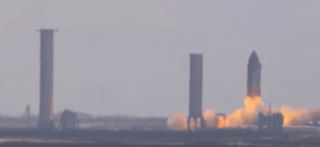SpaceX continues to prep its latest Starship prototype for a landmark orbital test flight.
The Starship SN20 vehicle ignited all six of its Raptor engines in a brief "static fire" test today (Nov. 12) at Starbase, SpaceX's facility near the South Texas village of Boca Chica.
"Good static fire with all six engines!" SpaceX founder and CEO Elon Musk tweeted shortly after the test, which took place at 1:13 p.m. EST (1813 GMT; 12:13 p.m. local Texas time) and was webcast by NASASpaceflight.comand SPadre.com.
Photos: SpaceX lifts huge Super Heavy rocket onto launch stand

SpaceX is developing Starship to take people and cargo the moon, Mars and other distant destinations. The system consists of two fully reusable elements: a giant first-stage booster called Super Heavy and a 165-foot-tall (50 meters) spacecraft known as Starship.
SpaceX has launched Starship prototypes before, sending a handful of three-engine vehicles to a maximum altitude of about 6 miles (10 kilometers). But SN20 will make a much bigger leap: It's being groomed to launch atop a Super Heavy on the first-ever Starship orbital test flight, which SpaceX aims to launch in the coming weeks or months.
The timing of that liftoff is unclear, partly because the U.S. Federal Aviation Administration (FAA) is still conducting an environmental assessment of the Starbase orbital launch site. The FAA has filed a draft assessment and collected public comments on the document, but the final report has not yet been released.
Get the Space.com Newsletter
Breaking space news, the latest updates on rocket launches, skywatching events and more!
Today's test wasn't the first static fire — a trial in which rocket engines are briefly engaged while the vehicle remains anchored to the ground — for SN20. SpaceX performed back-to-back static fires with the vehicle on Oct. 21, but SN20 had just two Raptors installed at that point. Today's test involved the flight configuration of six engines — three standard "sea level" Raptors and three optimized to perform in the vacuum of space.
Mike Wall is the author of "Out There" (Grand Central Publishing, 2018; illustrated by Karl Tate), a book about the search for alien life. Follow him on Twitter @michaeldwall. Follow us on Twitter @Spacedotcom or on Facebook.
Join our Space Forums to keep talking space on the latest missions, night sky and more! And if you have a news tip, correction or comment, let us know at: community@space.com.

Michael Wall is a Senior Space Writer with Space.com and joined the team in 2010. He primarily covers exoplanets, spaceflight and military space, but has been known to dabble in the space art beat. His book about the search for alien life, "Out There," was published on Nov. 13, 2018. Before becoming a science writer, Michael worked as a herpetologist and wildlife biologist. He has a Ph.D. in evolutionary biology from the University of Sydney, Australia, a bachelor's degree from the University of Arizona, and a graduate certificate in science writing from the University of California, Santa Cruz. To find out what his latest project is, you can follow Michael on Twitter.
